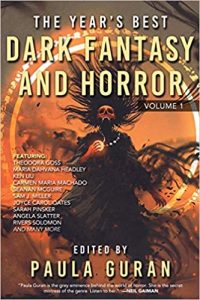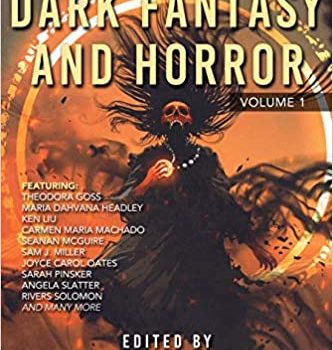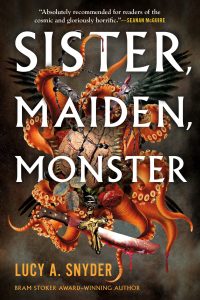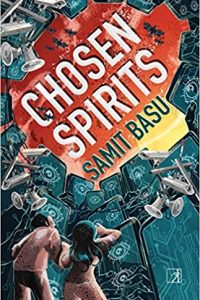Arley Sorg Reviews The Year’s Best Dark Fantasy & Horror: Volume One, Edited by Paula Guran
 The Year’s Best Dark Fantasy & Horror: Volume One, Paula Guran, ed. (Pyr 978-1645060253, $19.95, 440pp, tp) October 2020.
The Year’s Best Dark Fantasy & Horror: Volume One, Paula Guran, ed. (Pyr 978-1645060253, $19.95, 440pp, tp) October 2020.
Paula Guran started her The Year’s Best Dark Fantasy & Horror series in 2010 with Prime Books. After working as a senior editor for Prime for seven years, Guran parted ways with the company and published the final installment in that series in 2019. Guran returns in 2020 with no time to spare, restarting the series at volume one with new publisher Pyr – a company which, coincidentally, had also seen some major changes: they were sold by Prometheus Books in 2018 and picked up by Start Media. Despite being slightly trimmer than previous volumes, The Year’s Best Dark Fantasy & Horror: Volume One stays true to form, presenting an excellent assortment of work, drawing from best-selling and award-winning authors established outside of dark fantasy and horror, such as Pat Cadigan, Maria Dahvana Headley, Ellen Klages, Ken Liu, Carmen Maria Machado, Joyce Carol Oates, Sarah Pinsker, and Fran Wilde; as well as authors who will excite the horror and dark fantasy fans, such as Marissa Lingen, Seanan McGuire, and Rivers Solomon. Each story comes with an author bio, and the back of the book has an additional list of recommended stories.
Guran is a seasoned editor. Roughly a hundred or so titles have benefitted from her discernment. She did two brief stints as a magazine editor, wrote a slew of non-fiction, and has about 50 anthologies to her name. She is an expert in the field, one who should probably appear on awards ballots more often than she does. At the very least, seeing her history, you know that when you pick up this latest book, you are bound to find a great number of pieces which speak to you.
The Year’s Best Dark Fantasy & Horror: Volume One opens with Sunburst Award winner “The Fourth Trimester Is the Strangest” by Canadian author Rebecca Campbell. The writing is initially beautiful and mesmerizing, drawing the reader in to a very personal story about the vulnerability of children. Originally published in F&SF, this piece is a great way to set the tone for the volume.
Sam J. Miller’s “Shattered Sidewalks of the Human Heart” showcases the author’s expertise with character, while developing a remarkable intimacy between reader and narrative within a few paragraphs. A New York City cab driver picks up an unusual fare: Ann Darrow, the woman King Kong had held in his palm. The conversation and story which ensues renders the experience of Kong as personal and meaningful. It examines the hyperbole of cinema against the fantastic aspects of the real. This story is about heartbreak and its consequences, as well as wartime anxiety and pain. Perhaps above all, it’s about strange but heartfelt connections.
“The Promise of Saints” by Angela Slatter is a biting commentary on marriage as ritual, told in an elegant fashion; classic literary style meets fairy tale. Adalene brings her daughter Elspeth to see the Sainted Maiden at the Church of Mary’s Mercy, hoping that a visit to The Hallowed Girl will guarantee a good marriage for Elspeth. Even as a child, though, Elspeth has different ideas. The meeting awakens an unexpected kind of dedication in Elspeth, and may have awakened more than that.
In “Logic Puzzles” Vaishnavi Patel digs into the complexities of the immigrant experience. On one level, this story is about generational conflicts, including the kinds of sacrifices and demands one makes when undertaking geographical and cultural transitions, and the ways that small things can have massive consequences. Excellent subtext includes a critique of the capitalist machine and, perhaps more importantly than all of this (because it is more rarely explored), the way these transitions can foster a shame of one’s own cultural heritage and, by extension, self-hate. It’s all put together wonderfully and comes to a startling – but logical – conclusion.
In Nghi Vo’s “Boiled Bones and Black Eggs” a young girl ends up at The Drunken Rooster, an inn owned by her aunt by marriage. The inn serves travelers and locals alike, but also serves the restless and rowdy dead. The writing makes great use of details to vividly render place and people. This is a story about food and family and hospitality, while also being a story about feeling out of place. Finally, it’s a satisfying tale of wonderful characters in a pitched battle of wits.
Del Sandeen’s “In That Place She Grows A Garden” is, perhaps, pushing the limits of what might be called dark fantasy, let alone horror. All the same, this piece brings the fantastic to a conversation on an all-too common problem in schools. Rayven James is a Black student at a Catholic school. When a new principal joins the faculty, Rayven is told she must cut her locs, which she’s been working on for four years. What happens next surprises everyone, including Rayven. This is a really cool story; it’s creative, surprising, and important.
Some might argue about the definitions of these terms, “dark fantasy and horror,” and whether or not they apply to a few of the selections. Guran herself, in the introduction to her 2019 Year’s Best, said “I gave up trying to define horror a long time ago and have never tried to clarify the meaning of dark fantasy.” In the introduction to this volume, she says, “Dark fiction isn’t escapist, it confronts reality and helps us comprehend it.” Regardless of definitions, Guran has put together yet another wonderful anthology. I’ve listed a few pieces which were standouts for me. I have no doubt that readers will be impressed by the stories Guran offers in this new volume one.
This review and more like it in the January 2021 issue of Locus.
 While you are here, please take a moment to support Locus with a one-time or recurring donation. We rely on reader donations to keep the magazine and site going, and would like to keep the site paywall free, but WE NEED YOUR FINANCIAL SUPPORT to continue quality coverage of the science fiction and fantasy field.
While you are here, please take a moment to support Locus with a one-time or recurring donation. We rely on reader donations to keep the magazine and site going, and would like to keep the site paywall free, but WE NEED YOUR FINANCIAL SUPPORT to continue quality coverage of the science fiction and fantasy field.
©Locus Magazine. Copyrighted material may not be republished without permission of LSFF.








I’m struggling to grasp the logic behind classifying Maria Dahvana Headley, Carmen Maria Machado, and Joyce Carol Oates as “authors established outside of dark fantasy and horror” to be contrasted with “authors who will excite the horror and dark fantasy fans.”